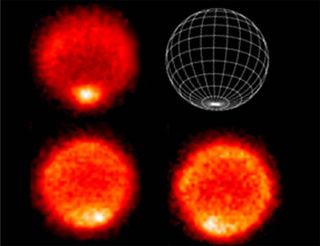What is Neptune's Temperature?
Neptune, the eighth and last planet from the sun, is one of the coldest. But despite its great distance, the planet undergoes seasons much like the Earth, creating warmer spots on the planet.

An icy atmosphere
Neptune is one of the two planets classified as an "ice giant." Like Uranus, its composition is made up more heavily of ices than the gas giants of Jupiter and Saturn.
Neptune's atmosphere is composed predominantly of hydrogen and helium, with traces of methane to create the bluish color. Unlike the terrestrial planets, Neptune and the other gas giants still hold much of the atmosphere they had at their formation. Temperature and pressure shift at different heights. The average temperature at the top of the cloud tops is minus 346 degrees Fahrenheit (minus 210 degrees Celsius).
Like the other gas giants, the enormous planet lacks a solid surface. Instead, the gas stretches down to the water-ammonia ocean that makes up the planet's mantle. Scientists have defined the "surface" of Neptune as the region where the surface pressure is equivalent to the pressure on Earth at sea level. The temperature at this "surface" is approximately minus 346 F (minus 201 C).
The planet's average temperature is minus 353 F (minus 214 C). But despite being the most distant planet, it is not the coldest. That honor goes to the seventh planet, Uranus, which is closer to the sun. At such vast distances, however, the two ice giants take in very little heat from the star. Neptune's temperature is driven more by the motions within its interior than by the rays of the sun, motions that Uranus doesn't seem to share.
The long summer
Like other planets on the solar system, Neptune doesn't sit completely parallel to the sun. Instead, it is tipped on its side at a 28.3 degree angle (for comparison, Earth is tipped at a 23.4 degree angle). This tilt gives rise to seasons. However, the distance to Neptune from the sun is enormous--on average, the planet is 2.8 billion miles (4.5 billion kilometers) from the heat-giving star. As a result, the pole tipped toward the sun reaches higher temperatures than the rest of the planet for a quarter of a Neptunian year, or for about 40 Earth-years.
In 2007, when the south pole was still tipped toward the sun, scientists found that the upper cloud layer in the region was about 50 degrees F (10 C) warmer than the rest of the planet, allowing some of the methane to leak out into space.
These seasonal changes also affect cloud motion in the atmosphere.
— Nola Taylor Redd, SPACE.com Contributor
Related:
Join our Space Forums to keep talking space on the latest missions, night sky and more! And if you have a news tip, correction or comment, let us know at: community@space.com.
Get the Space.com Newsletter
Breaking space news, the latest updates on rocket launches, skywatching events and more!

Nola Taylor Tillman is a contributing writer for Space.com. She loves all things space and astronomy-related, and enjoys the opportunity to learn more. She has a Bachelor’s degree in English and Astrophysics from Agnes Scott college and served as an intern at Sky & Telescope magazine. In her free time, she homeschools her four children. Follow her on Twitter at @NolaTRedd
